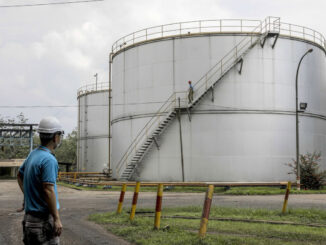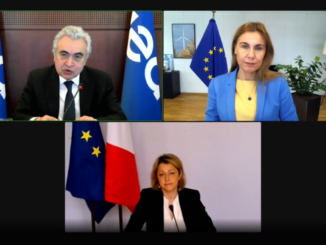
The IEA Oil Market Report (OMR) is one of the world’s most authoritative and timely sources of data, forecasts and analysis on the global oil market – including detailed statistics and commentary on oil supply, demand, inventories, prices and refining activity, as well as oil trade for IEA and selected non-IEA countries.
- Soaring oil use for power generation and gas-to-oil switching are boosting demand. In this Report, we have raised our estimates for 2022 global demand growth by 380 kb/d, to 2.1 mb/d. Gains mask relative weakness in other sectors, and a slowdown in growth from 5.1 mb/d at the start of the year to less than 100 kb/d by 4Q22. World oil demand is now forecast at 99.7 mb/d in 2022 and 101.8 mb/d in 2023.
- World oil supply hit a post-pandemic high of 100.5 mb/d in July as maintenance wound down in the North Sea, Canada and Kazakhstan. OPEC+ ramped up total oil production by 530 kb/d in line with higher targets and non-OPEC+ rose by 870 kb/d. World oil supply is set to rise by a further 1 mb/d by year-end. In this Report, we revise up our forecast for Russian oil output but have lowered the outlook for North America.
- Refinery throughputs rose by 1.1 mb/d in July and are set for a further 350 kb/d gain this month, when runs will reach their highest level since January 2020. The increase was above refined product demand, driving cracks and refinery margins sharply below the all-time highs seen in June. Global refinery runs are now on track to rise by 2.6 mb/d in 2022 and 1.3 mb/d next year.
- Russian oil exports fell by 115 kb/d in July to 7.4 mb/d, from about 8 mb/d at the start of the year. Crude and oil product flows to the US, UK, EU, Japan and Korea have slumped by nearly 2.2 mb/d since the outbreak of the war, two-thirds of which have been rerouted to other markets. Export revenues fell from 21 bn in June to $19 bn in July, on both reduced volumes and lower oil prices.
- Global observed inventories fell by a marginal 5 mb in June, with a drawdown in both OECD and non-OECD stocks partially offset by an increase in oil on water. OECD total industry stocks increased by 6.2 mb, to 2 681 mb but remained 292.1 mb below the five-year average. Government stocks released to the market totalled 33.8 mb in June, the largest drawdown since March.
- Benchmark crude oil futures have sunk by around $30/bbl since a June peak as worsening economic prospects and oil demand growth weighed on sentiment. At the time of writing, Brent traded at around $97/bbl and WTI $92/bbl. Steadier forward prices flattened backwardation across the futures curve and prompt physical premiums eased.
Rising oil supplies and escalating concerns over the deteriorating economic outlook have knocked around $30/bbl off prices from a peak in June. For product prices and refinery margins, the plunge has been even steeper as a sharp run-up in refinery activity collided with lacklustre driving demand during the Northern Hemisphere summer season. At the time of writing, ICE Brent futures were around $97/bbl while NYMEX WTI were trading at $92/bbl.
At the same time, natural gas and electricity prices have soared to new records, incentivising gas-to-oil switching in some countries. With several regions experiencing blazing heatwaves, the latest data confirm increased oil burn in power generation, especially in Europe and the Middle East but also across Asia. Fuel switching is also taking place in European industry, including refining. In this Report, we have revised our forecast for world oil demand higher for the remainder of the year, but growth is nonetheless expected to slow from 5.1 mb/d in 1Q22 to a marginal 40 kb/d by 4Q22. World oil demand is now seen rising by 2.1 mb/d in 2022 to 99.7 mb/d and by a further 2.1 mb/d next year, when it surpasses pre-Covid levels at 101.8 mb/d.
The outlook for world oil supply has been revised upward, with more limited declines in Russian supply than previously forecast. While Russia’s exports of crude and oil products to Europe, the US, Japan and Korea have fallen by nearly 2.2 mb/d since the start of the war, the rerouting of flows to India, China, Türkiye and others, along with seasonally higher Russian domestic demand has mitigated upstream losses. By July, Russian oil production was only 310 kb/d below pre-war levels while total oil exports were down just 580 kb/d. The EU embargo on Russian crude and product imports that comes into full effect in February 2023 is expected to result in further declines, as some 1 mb/d of products and 1.3 mb/d of crude would have to find new homes.
In a largely symbolic move, OPEC+ agreed in early August to raise its supply target by just 100 kb/d for September, significantly lower than the July and August scheduled increases of 648 kb/d. The group noted that “severely limited” spare capacity should be used with “great caution in response to severe supply disruptions”, suggesting that substantial further OPEC+ output increases are unlikely in the coming months.
Even so, builds in global inventories are now projected at around 900 kb/d during the rest of this year and 500 kb/d over the first half of 2023. The release of additional emergency stocks through at least October will provide further relief. By end-June, around 150 mb of the volumes committed through IEA collective actions and individual IEA member SPR sales had yet to find its way to the market. With OECD industry stocks still some 290 mb below their five-year average, such builds could help ease market tensions. But with supply increasingly at risk to disruptions, another price rally cannot be excluded.




